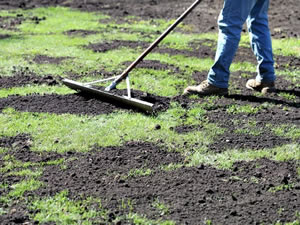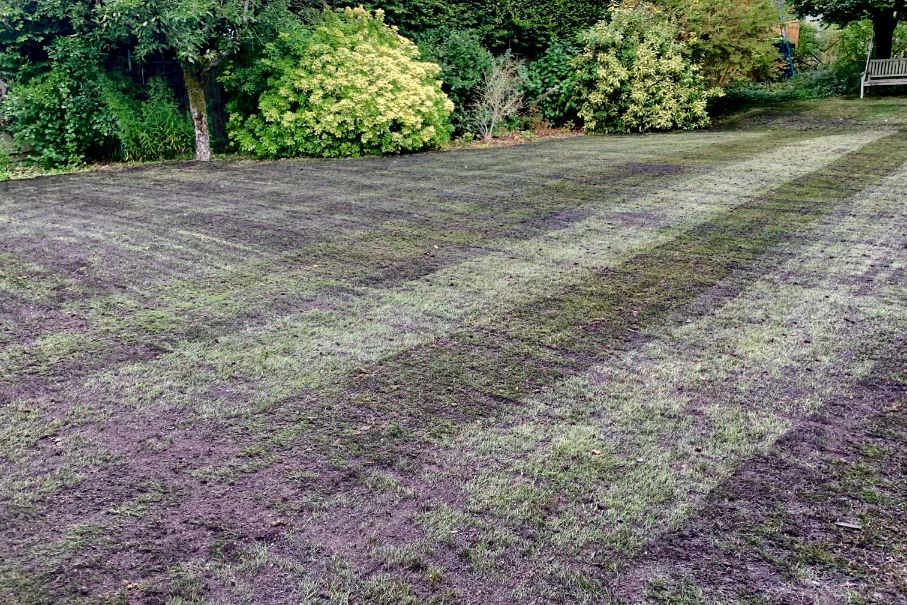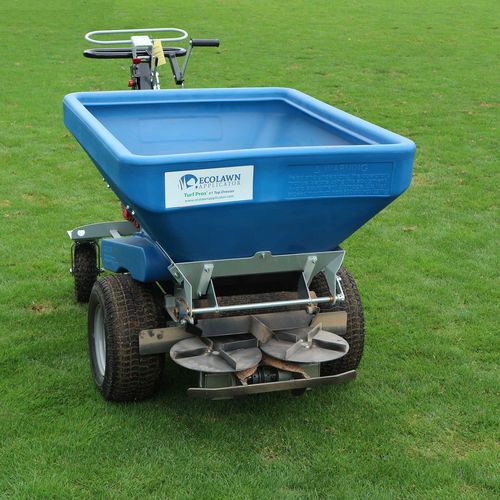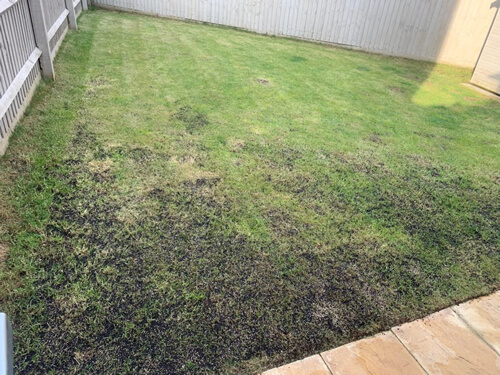Why top-dress your lawn?
- Topdressing helps to boost microbial activity creating healthier growing conditions
- Uneven lawns can be improved with the application of topdressing
- Lawn seed germination will be improved with the application of lawn dressing
- Soil condition will be improved through regular application of appropriate dressing
If your lawn is in poor condition consider the application of topdressings to bring it back to health

When should I top-dress my lawn?
How much top-dressing should I use?
Do I need to seed after top-dressing?
Top-dressing a lawn?
Lawn topdressing briefly explained…
- Topdressing applies a thin layer of fine material over the surface of the lawn
- Once applied, the dressing should be worked into the surface of the lawn with a brush or drag mat
- Different mix blends of topdressing may be used depending on the purpose
- Be careful not to apply too much which may smother the grass

What is lawn top-dressing?
Topdressing is a process rather than a product. The process of topdressing is the application of a suitable material to the surface of the lawn to achieve specific results.
Why should I top-dress my lawn?
There are a number of different reasons to apply a top dressing to a lawn. The problems you are looking to solve will dictate the type of lawn dressing used. Sometimes professional, quality dressings will need to be added over a number of years to correct a major lawn issue. These issues could be related to soil condition, drainage, uneven surfaces, or problems with worm casts
Lawn dressing and thatch
Thatch is a build-up of organic matter. This organic matter can be broken down into free grass nutrition by beneficial soil microbes. Lawns low in microbial activity are likely to have more issues with the build-up of lawn thatch. We no longer use peat as it is unsustainable. By applying a compost-based lawn dressing mix to the turf, soil microbial activity will be boosted. These soil microbes will begin to break down the thatch layer and release nutrients back into the soil, greatly improving soil health and benefitting your lawn resulting in healthy, green, grass growth.
Lawn top-dressing to level a lawn
Lawns can become uneven over time. Often turf that has recently been laid will settle, resulting in bumps and hollows. Winter soil movement can also cause your lawn to become uneven in the spring. Uneven lawns are more difficult to mow, and the mower blades may cut too short in some areas resulting in bare spots susceptible to moss and weed invasion. Applying a lawn dressing and working this into the lawn surface with a lute or drag mat will knock it off the high points and drop it into the hollows or holes, greatly improving the surface of the lawn
Lawn top-dressing for worm cast problems
Some lawns can really suffer with worms bringing soil to the surface. These worm casts are flattened by mowing or walking on the lawn. This results in a patch of bare soil where seeds can germinate, or moss can begin to colonise the lawn. Worm casts also make mowing the lawn difficult and can be unsightly. By dressing the lawn regularly with a sandy lawn dressing you can greatly reduce the difficulty of dealing with worm casts on a lawn
Lawn top-dressing to improve drainage
Certain soil types are more likely to suffer with poor drainage. Waterlogging makes it very difficult to maintain a healthy lawn and may result in grass die back and unsightly bare areas. If you have a lawn which is regularly suffering with drainage issues the structure of the soil may need to be improved. Once way to do this is by regularly top-dressing the lawn with the right blend of dressing depending on the soil type your currently have. Typically, sandy, or compost-based dressings will help to improve these issues
New-build properties with lawn problems
Increasingly we are asked by disappointed owners of newer properties why it is that they can’t grow good grass. Often we find this is due to the poor soil that the lawn was laid on. This poor soil can be improved by the addition of the right lawn dressing. A mix of sand and loam or sand and compost dressings, spread at a relatively high quantity will help in the renovation of poor quality clay soils and often provide noticeable benefits.
Do I need to seed my lawn after I have top-dressed?
This very much depends on why you were topdressing in the first place. If your lawn is bare then over-seeding your lawn with the correct blend of grass seed will improve this situation. Regular over-seeding is good practice and therefore there is little harm to be done by seeding the lawn surface at the same time as topdressing it. Just be careful not to bury the grass seed too deep.
How much lawn dressing should I apply?
Depending on the reason for dressing depends on the amount of dressing to use. Typical rates would be between 3 and 5 kg per square meter. It is better to apply little and often than to apply too much and smother the grass beneath.
When is the best time to dress my turf?
In lawn care we would generally recommend that you evenly spread a suitable mix of lawn dressing on top of the turf in the spring or autumn. Summer is fine too but our advice would be not to carry out this work in the winter or a time of drought, when grass isn’t growing. The benefits may be greater after aeration, as this enables the mix to drop into the holes created when you aerate and come closer to the roots.
How to top-dress a lawn
- First ensure the lawn has been mowed relatively short
- Measure the lawn and calculate the correct amount of lawn dressing needed
- Apply the correct blend of dressing for the problem you are addressing
- Apply evenly across the surface of the lawn
- Work the dressing into the surface with a lute, drag mat or the back of a rake
- If required, over-seed the lawn after the dressing has been applied
- Apply a suitable lawn fertiliser and if rain is not due then water the lawn well

Specialist equipment ensures a professional result

Regular lawn dressing greatly improves grass

 Established 2016
Established 2016



